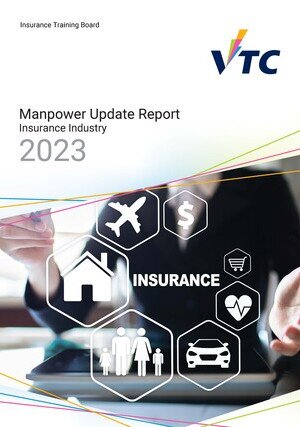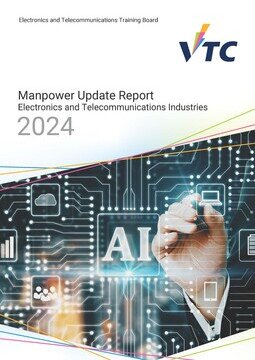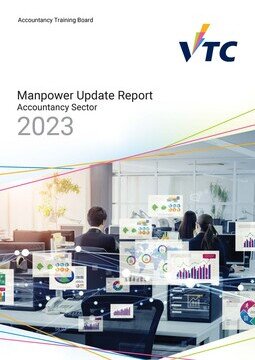How Do We Analyse Manpower Dynamics ?
VTC assesses the manpower demand for 24 major industry sectors covering more than 80% of the Hong Kong working population. The manpower dynamics of each of the 24 industries in Hong Kong is analysed through manpower survey and manpower update in a 4-year cycle. The manpower survey is a quantitative survey conducted with relevant companies once every 4 years to collect information of employees count, income, education, and so on. The manpower update is conducted twice in the 4-year cycle through focus group meeting with industry representatives and data analytics of major recruitment platforms. The information obtained from both manpower survey and manpower update aims to facilitating the Government and different stakeholders of industries for formulation of manpower and training plan.
Manpower Survey Tooltips

Companies
Enumerator
4-Year Cycle
Manpower Update Tooltips

Latest Report

- Maritime Services
- 2024 Manpower Update Report
Growing needs for IGF Code and ESG training
The need for mandatory training on the International Code of Safety for Ships using Gases or other Low-flashpoint Fuels (IGF Code) is growing very fast since the number of Liquefied Natural Gas (LNG) ships is rising rapidly. While local training is not available due to the lack of expertise, local training providers may consider offering relevant programmes in collaboration with Mainland/overseas institutes.
In the meantime, there have been growing concerns over sustainable shipping and responsible business practices within the industry. Investors, customers and insurers are integrating Environment, Social and Governance (ESG) risk factors into their decision-making processes. Maritime executives should be equipped with ESG concepts including ESG-related regulations, key ESG indicators applicable to the industry, as well ESG reporting framework, to assist their organisations in adopting appropriate ESG strategies.

- Fashion and Textile
- 2023 Manpower Survey Report
Creativity Shines: A Blend of Technology, Tradition and Care for Sustainability
The future of the fashion and textile industry will be characterised by sustainability, digital transformation, and technology integration. The industry will prioritise sustainable and ethical production practices while embracing digital technologies and e-commerce platforms to expand market reach, improve operational efficiency, and drive sales. The Government's support for arts, culture, and creative industries will create opportunities for eastern and western cultural integration. To fuel further growth in the industry and position Hong Kong as a global hub for artistic expression and creativity, it is essential to attract young creative talents who can bring fresh ideas, innovation, and energy. Additionally, engaging retired experienced artisans can help preserve valuable traditional craftsmanship and inspire young professionals to combine traditional techniques with modern practices.

- Electronics and Telecommunications
- 2024 Manpower Update Report
Immense Potential of Artificial Intelligence and Big Data
Artificial intelligence (AI) and big data analytics technologies have driven the digital transformation of businesses as well as creating new business opportunities and services, and improving the business operational efficiency and effectiveness. For the electronics and telecommunications (EC) industries, AI is a tool with immense potential and its applications are not to substitute existing processes but to explore new business opportunities and create new job positions. Big data will contribute to business operations enhancement through data-driven analysis and forecasting. Its applications can extend to provide data analytics services and solutions to other sectors and industries. The EC industries are one of the leading industries to drive innovation & technology (I&T) development in Hong Kong and support the I&T development of other sectors.

- Building, Civil Engineering and Built Environment
- 2024 Manpower Update Report
Extended Adoption of Advanced Construction Technologies
The industries would face the dilemma of insufficient manpower due to the heavy construction volume in the coming decade. It was anticipated that the manpower shortage would become increasingly acute at all skilled worker, technician and professional levels. Leveraging innovative construction technologies has been proven to uplift the productivity and efficiency of construction works, improving the effectiveness of work supervision, as well as enhancing site safety performance. The scope of advanced technologies implementation in the industries has been extended in recent years. Nevertheless, the industries were still in the transition period to gradually adapt and implement such technologies into construction practices. Efforts and time had to be put into equipping industry practitioners from front-line workers to senior managerial members with relevant skills and knowledge.

- Electrical and Mechanical Services
- 2024 Manpower Update Report
Electrical & Mechanical Services Industry in the Post-Covid Era: Challenges and Opportunities
In the post-Covid-19 era, construction projects have hurried to make up for lost time during the pandemic, alongside government large-scale construction initiatives and the renovation of many old buildings, aiming to replace or modernize building facilities. This has led to increased demand for manpower in E&M engineering services. Hong Kong's railway has resumed normal schedules after the pandemic, resulting in greater wear and tear on its E&M components, thus sparking high demand for skilled maintenance workers. Despite the stable demand for electricity and natural gas before and after the pandemic, household consumption rose due to lifestyle changes, particularly in peak hours. Expectations of government initiatives for housing and infrastructure suggest continued sector growth. The aviation industry has gradually resumed after the pandemic, with airport traffic reaching 80% of pre-pandemic levels. As a result, there is an increased demand for aircraft maintenance services, especially with the opening of the third runway at the Hong Kong Airport by the end of 2024. Employers emphasise the importance of mastering BIM drawing for students in E&M engineering programs. Technologies like Modular Integrated Construction (MiC), Design for Manufacture and Assembly (DfMA), and Multi-trade Integrated Mechanical, Electrical, and Plumbing (MiMEP) have gained popularity in recent years. These technologies, which involve factory assembly and on-site installation, shorten construction timelines. These require E&M professionals to adapt to and continuously learn relevant skills. As climate change drives the transition towards renewable energy, mechanical and electrical engineers must possess relevant skills. Adaptability to evolving technologies and environmental standards is crucial for professionals in the E&M Services industry.

- Print Media and Publishing
- 2024 Manpower Update Report
Sustainable Development of the Print Media and Publishing Industries
Facing the rapid technological strides and evolving digital era, the print media and publishing industries have to formulate their business strategies to embrace digital transformation and cultivate multi-skilled talents specialising in digital and social media marketing. To support the manpower development of the industries, the Government, enterprises and training institutions should further collaborate and promote the professional image of the industries and provide incentives for talent development and retention. For employees and young people, it would be essential to have a global vision as well as stay open to explore new opportunities and develop their career beyond Hong Kong.

- Catering
- 2022 Manpower Survey Report
An Encouraging Business Environment
Hong Kong has returned to normalcy in the post-COVID 19 era. The fast and convenient links with the Mainland and the rest of the world have resumed and different businesses in the city are gradually reviving. The Government has also launched the "Happy Hong Kong" campaign, which features a wide range of fun and interesting activities across Hong Kong for citizens to enjoy happy moments together. It is hoped that the campaign can help stimulate local consumption and boost the economy.

- Hotel
- 2022 Manpower Survey Report
Road to Recovery in the Post-pandemic Era
Notwithstanding the recession that Hong Kong’s economy has fallen into since the pandemic outbreak, many economic indicators, including “Quarterly business indices of accommodation service” from the Census and Statistics Department, and “Provisional visitor arrivals”, “Overnight visitor arrivals by country / region of residence”, and “Hotel Room Occupancy” announced by the Hong Kong Tourism Board, have shown that Hong Kong has returned to normalcy and the Hotel industry has been gradually on the road to recovery.

- Insurance
- 2023 Manpower Update Report
Preparing Insurance Workforce for the New Normal
The insurance industry in Hong Kong is navigating both opportunities and challenges in the global business landscape. The Government has set its sights on establishing the city as a regional insurance hub. Although the COVID-19 pandemic initially caused a decline in gross premiums, the reopening of borders in 2023 sparked robust demand for long-term insurance from mainland customers. Regulatory measures like IFRS 17 and the forthcoming RBC regime are enhancing transparency and bolstering financial stability. Technological advancements, including digitalization, AI, and big data, are streamlining processes and broadening the customer base through personalized services. Insurance agents are adapting by providing consultancy services and tailored solutions, setting themselves apart from online platforms. The industry also recognises the increasing necessity for skilled professionals who possess expertise in insurance knowledge, commercial acumen, digital skills, risk management, compliance, actuarial proficiency, and innovation. It is imperative to invest in upskilling and reskilling existing staff to meet the evolving demands of the industry.

- Accountancy
- 2023 Manpower Update Report
Evolving Talent Needs in Accountancy Sector Amid Economic and Industry Shifts
Hong Kong's economic recovery after gradual resumption to post-pandemic normalcy are anticipated to stimulate growth in the accounting sector, despite potential obstacles like declining global demand and high interest rates. Recent regulatory changes have aligned the accounting profession with international standards, compelling it to consistently elevate the level of quality among professional accountants and, in turn, safeguard the public interest. COVID-19 pandemic has accelerated the shift of accountants into strategic advisory roles, requiring a more diverse skill set. The Greater Bay Area's growth, amplified by increased business opportunities, cross-border collaboration, and technological advancements, is expected to boost demand for professional accounting services. The report also emphasises the industry's clerical staff shortage and the need for skilled mid-tier personnel, discussing the impact of emigration trends and the rising demand for accountants in burgeoning areas like ESG initiatives and innovative financial products.


Do You Know?
Fun Facts about the Jewellery and Timepiece Industry
A Breakthrough from the Tradition
Regardless of whether it is a traditional mechanical watch or a modern smartwatch, most of them feature a square or round watch case. As early as 1967, Cartier introduced the “Crash” watch - the world’s first asymmetrical design with a twisted case and dial. The irregular shape of the “Crash” made it challenging to achieve accurate time indication, the core function of a watch. After multiple deconstructions, redesigns, and reconstructions, the first distinctive, visually soft, and fully functional Crash watch finally made its debut. The Crash series has always been acclaimed as Cartier’s breakthrough work and has gained recognition from many celebrities. It’s no wonder that this “twisted beauty” has become highly valuable in the market.










































